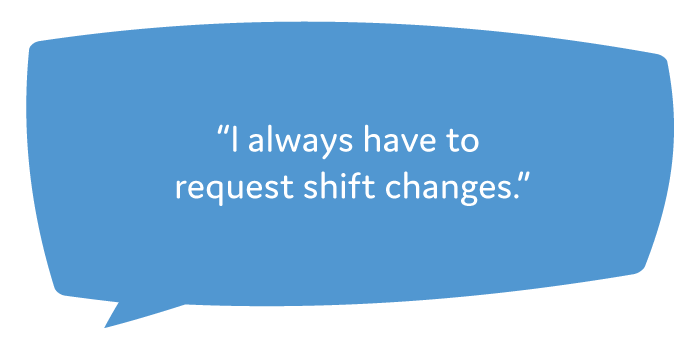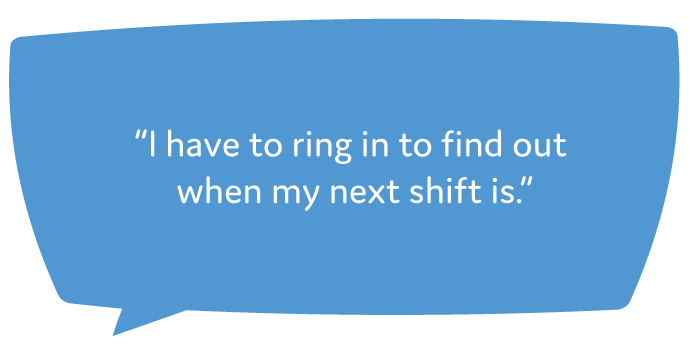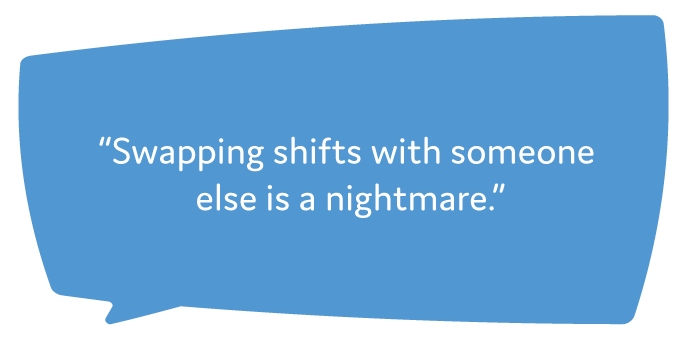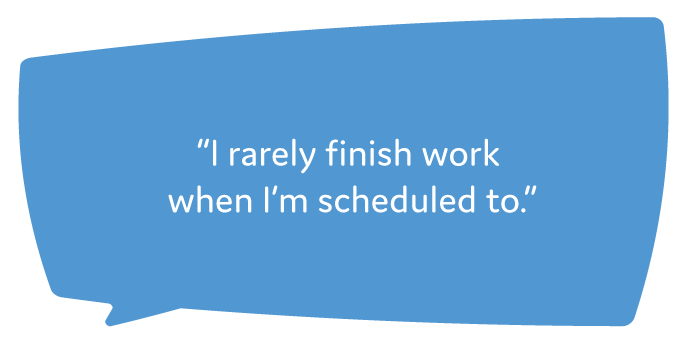(Updated: 04/01/24)
Creating rotas without the aid of rota planning software can be a bit of a nightmare.
Schedule too many staff for a shift and you end up paying people to stand around. Schedule too few and you risk bad customer service — not to mention overworking your staff, who might decide to take their skills elsewhere.
But even when you've spent hours poring over your rota and making sure that you have the right number of people in the right place at the right time, a rota can cause all manner of HR headaches once it's up on the wall.
Check out these nine common rota complaints and ideas on how to avoid them.

1. Your rotas are messy or never follow the same format
It’s the rota planner’s job to make sure that the staff schedule is easy to understand. Changing the layout from week to week or suddenly switching colour schemes will only cause confusion, and could result in staff missing shifts or coming in when they’re not needed.
Whether you’re using dedicated rota-planning software, an Excel spreadsheet, or just plain old pen and paper, it’s important that you keep your rota tidy and stick to the same format from one week to the next.
Keep your rotas tidy and stick to a format that works — it’ll make everyone’s life easier.

2. You share your staff rotas at different times each week
It’s no fun hanging around waiting for your boss to finish next week’s rota. It’s also no fun being pestered by your employees when you’re frantically trying to fill all the gaps and avoid clashes.
Decide a day of the week for your new rotas to come out and stick to it like it’s the deadline for your tax return. Your staff will thank you, and it'll help your business run more smoothly.

3. You leave it too late to publish the next rota
As well as sticking to a routine, it’s important to prepare and share the next rota well in advance of the current one ending.
If you frequently find yourself working on the next rota with less than 24 hours to go before it's needed, then you risk making costly staffing errors.
You’re also more likely to have to make changes to the schedule once it’s up since staff will inevitably come to you with requests for changes.
Your employees will quickly grow tired of having to wait for their manager to tell them when they're next required to work, so ensure that you have at least three or four days between the day you release the rota and the day the existing one ends.

4. Your rotas aren't built around your staff
No matter how much you hate planning rotas, filling empty shifts with the first name available is a surefire way to end up with disgruntled employees.
If you know that it takes one of your staff almost an hour to get to work, for example, then it might be kinder to give them shifts later in the day rather than asking them to open up the shop in the morning. If you know that one of your employees is a student and has lectures early in the morning on particular days, try to keep them off late shifts the night before.
It may take a little longer to plan your rotas this way to begin with, but it will save you a lot of headaches down the line, and your staff will definitely appreciate it.

5. Changes to the rota changes aren't properly communicated
Even the best-planned rotas have to change on occasion. People call in sick; your system suddenly goes down; a big party books in on an ordinarily quiet night and you need more hands on deck.
But changing the rota once it's been sent out should always be a last resort. And if you do make a change, it needs to be communicated to the staff it will affect as soon as possible.
Making your employees aware of a change to their schedule can be as simple as giving them a call them at home, popping a memo in their pigeonhole, or, if you use rota-planning software, setting up automatic push notifications to be sent to their phone whenever you make an update.
Whatever method you choose, give your staff plenty of notice of any changes and be flexible if the revised rota doesn't work for everyone involved.

6. The rota isn't easily accessible
A common problem when using a paper rota is that staff who aren't around when it's put up will have no idea when they're next in.
Employees calling in to ask for their next shifts is common in some industries. But take five, ten, twenty calls like this for every rota you produce, and you and your team will end up wasting a phenomenal amount of time each year — not to mention potentially missing customer calls as you tie up the phone line.
There is no tried-and-tested workaround for the paper problem, but managers using Excel or Google Sheets for staff scheduling can send their finished rotas out to their entire team via email (just be sure to send out the new version every time you make a change).
Online rota software, meanwhile, will automatically send out updates to your staff when you publish your rota or make edits to it, so it's worth considering if you haven't already.

7. There's no system in place for requesting shifts
Lost, forgotten or ignored shift requests are a major bugbear for staff, and can sap morale.
It's impossible to please everyone on your team the entire time, but it's a good idea to have a set way for your staff to request particular shifts so you can try to work around them when planning your rotas.
Your system could be as simple as asking staff to write their names in red or green ink on a blank rota to indicate the shifts they'd like to take or would prefer not to work. Or perhaps you could enforce a "requests via email only" policy and have a cut-off time each week. Taking requests in person, however, should probably be avoided as the details often go forgotten.
Whatever method you choose, stick to it and make sure that requests don't go ignored. Even if you're not always able to honour every request, taking a moment to acknowledge individual staff won't go unnoticed.

8. You rule your rota with an iron fist
We get it — you worked hard on your rota and you don't want anyone to mess around with it.
But it’s often easier to let your staff negotiate shift swaps between them rather than insisting they come to you first (provided they can't make final changes without your consent).
Consider how much simpler it would be to approve a shift swap organised by two of your staff, than to have someone tell you they can't work a shift and leaving it to you to figure out the solution.
One feature of the RotaCloud app is that staff can request a shift swap with a fellow employee. They simply select the shift they want to trade and tap on an eligible coworker's shift to send them a request to swap.
If the second employee agrees to the switch, then their manager will receive a notification alerting them to the proposed change. All the manager needs to do is tap a button to approve or reject the swap, with everyone involved automatically receiving an updated version of the rota — no texts, emails, or hastily scribbled notes required.

9. You don't stick to your own rota
A common complaint from staff who work to a rota is that their boss expects them to follow it, but ignores it whenever it suits them.
"Even if I was scheduled to finish at five, my manager would very often tell me that there was still work to be done, and I'd be stuck there for an hour or more," a friend once confessed when discussing a job he'd had while studying at university.
"If I ever pointed to the rota, she'd flatly tell me that 'the rota is just a guide' and that finishing times weren't set in stone."
You wouldn't allow your staff to roll in half an hour later than they're scheduled to start work, so it's not fair to ignore their agreed finishing times just because the place is busier than expected.
Most employees will be happy to stay late every so often if it means making a bit of extra cash. But your staff will only respect your rota if you stick to it yourself.
If you routinely find yourself short at certain times, then it’s probably time to head back to the drawing board and adjust your staff’s shift patterns.
Final Thoughts
Staff scheduling is more complicated than it looks on the surface.
But with a little consideration and a good system in place planning the rota, distributing it, and making changes, it can form the backbone of your day-to-day operations.







